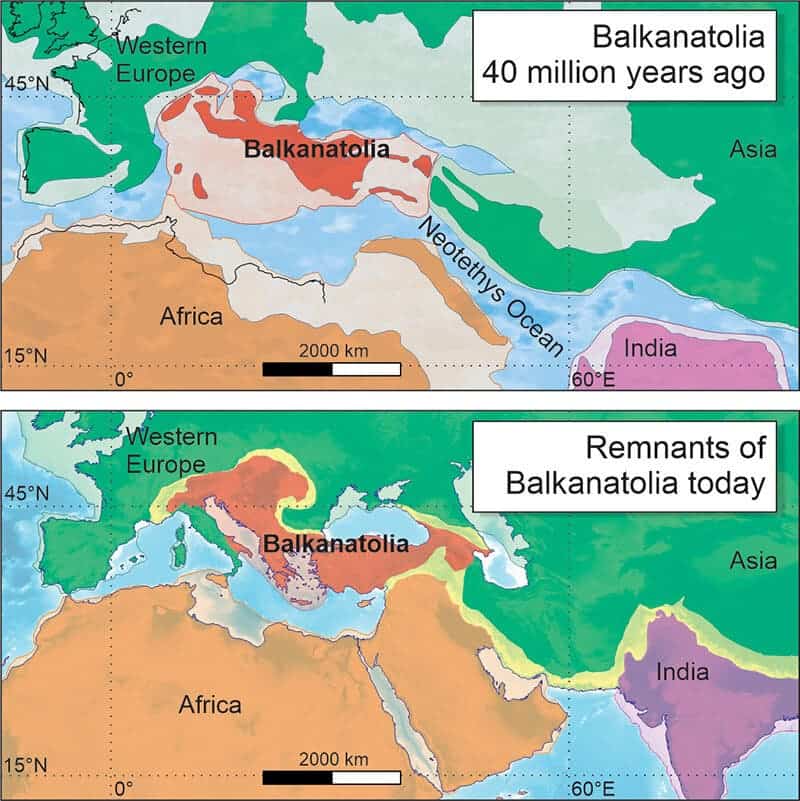
For millions of years, Western Europe’s megafauna was literally worlds apart from that in Asia, owed to impenetrable natural barriers that allowed species on both continents to evolve and diverge. But that all changed in the blink of an eye, geologically speaking, after the more robust and adaptable Asian mammals poured into Europe, where they quickly replaced the endemic fauna. How exactly this event, known as the Grande Coupure, panned out has always been a mystery, but a new study is filling the gaps in our knowledge by proposing an interesting hypothesis: the Asian mammals invaded through an ancient landmass called Balkanatolia.
If the name Balkanatolia rings a bell, it’s because it refers to the present-day regions of the Balkans and Anatolia, which 50 million years ago formed an isolated archipelago, separate from the neighboring continents of Europe, Africa, and Asia. The name Balkanatolia was recently given by researchers at the French National Center for Scientific Research in a new study that highlights the biogeographic province’s major role in the Grande Coupure, which occurred some 34 million years ago.
That’s because examinations of previous fossils found in both the Balkan peninsula and Anatalonia — some of which date as far back as the 19th-century– performed by the researchers led by paleogeologist Alexis Licht showed that Asian mammals started colonizing southern Europe as early as 5 to 10 million years prior to the Grande Coupure.
In a subsequent review of this fossil record, the researchers uncovered patterns that allowed them to reconstruct the biogeographic history of the region over the span of millions of years.
The researchers found that for much of the Eocene Epoch (55 to 34 million years ago), the Balkans and Anatolia harbored homogeneous terrestrial fauna, which was distinct from that in continental Europe and Asia. Some of these mammals included marsupials of South American origin and large herbivorous mammals resembling hippos, known as Embrithopoda. The presence of these distinct animals just makes sense for an isolated archipelago, which is why the researchers proposed the existence of Balkanatolia.
However, Balkanatolia would soon be greeted by some uninvited guests. New fossil deposits from Büyükteflek in Turkey, dated to 38 to 35 million years ago, clearly belonged to mammals with an Asian lineage — the earliest of their kind discovered in Anatolia until now. These include fossils belonging to Brontotheres, huge animals resembling large rhinoceroses that died out at the end of the Eocene.
From this amalgam of fossils from different eras, the researchers pieced together a story: Balkanatolia comprised a single landmass isolated from the rest of the continents beginning with 50 million years ago, but would be colonized some 40 million years ago by Asian mammals. How exactly these animals reached the archipelago is not understood, but it seems like the region became a stepping stone for the Asian mammal invasion. The straight Eurasian route through modern-day Russia was not a viable route due to the huge glaciers and other geographical obstacles.
It is likely that a major glaciation event, which lowered sea levels some 34 million years ago, formed a bridge between Balkanatolia to Western Europe, releasing the floodgates of invasive Asian species. In no time, Western Europe endemic animals like Palaeotheres, an extinct group distantly related to present-day horses, but more like today’s tapirs, became extinct and were replaced by more diverse and resilient fauna including mammal families found today on both continents.
In other words, these findings suggest that the Grande Coupure was actually a two-stage event. In the first event, Asian mammals colonized Balkanatolia, where they replaced much of the existing fauna. Then, taking advantage of shifting geographical conditions due to climate change, the invasive species continued their conquest in the rest of the European continent.
“This colonization event was facilitated by a drop in global eustatic sea level and a tectonically-driven sea retreat in eastern Anatolia and the Lesser Caucasus during the late middle Eocene. These paleogeographic changes instigated the demise of Balkanatolia as a distinct biogeographic province and paved the way for the dispersal of Asian endemic clades before and during the Grande Coupure in western Europe,” the authors wrote in their study published in Earth-Science Reviews.


